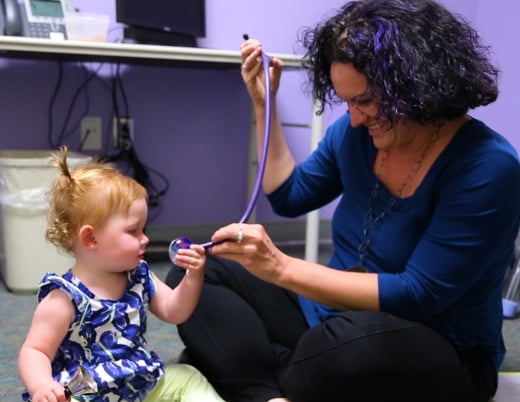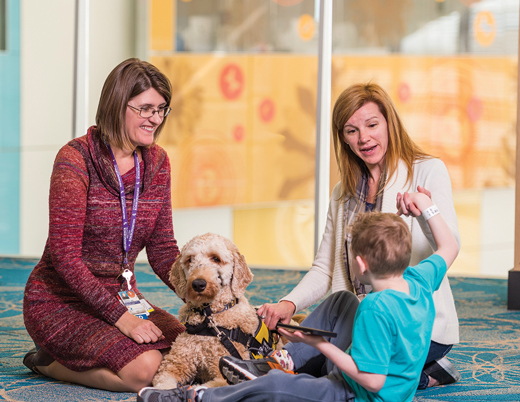What are the latest advances in treatment for children with rare skin disease?
Epidermolysis bullosa (EB), also known as butterfly skin disease for the dust-like scales that rub off when touching a butterfly, is a family of rare genetic conditions that causes fragility of the skin and mucosal membranes, leading to very painful blistering and scarring at even the slightest trauma. While there isn’t a cure, advances in standards of care have made it possible for patients with severe forms of EB to live into middle adulthood and beyond. Leaning on new research, Children’s Hospital Colorado has developed a multidisciplinary program dedicated to creating more effective therapies and ultimately finding a cure.
There’s no one-size-fits-all treatment
There’s no one-size-fits-all approach to treating EB, in part due to variations of findings between the main EB subtypes (EB simplex, junctional EB, dystrophic EB and Kindler EB), which range from mild and localized blistering to severe and debilitating wounds and scarring. Treatments focus on supportive care, consisting of wound care, infection control, nutrition support, pain management and prevention of complications.
“EB is a delicate and complex condition that requires a specialized multidisciplinary pediatric team, from dermatologists to physical and occupational therapists and even specialized anesthesiologists,” says pediatric dermatologist Anna Bruckner, MD. “All our specialists are well-versed in the nuances of caring for patients with EB and understand that a simple mistake, like using tape or regular bandages on the surface of the skin, can be damaging to patients.”
One particularly severe form of EB, recessive dystrophic EB (RDEB), is especially challenging to treat. RDEB is caused by a deficiency in type VII collagen (C7), which is responsible for properly connecting the skin’s two main layers at the dermal-epidermal junction. In addition to severe wounds, blistering and scarring, patients experience malnutrition, anemia, esophageal strictures, dental problems, and fusion of the fingers and toes due to chronic scarring. These wounds predispose patients to infections, and they can develop into aggressive squamous cell carcinomas in adolescents and adults — a major cause of death among these patients. But there are two very promising therapies on the horizon: focal gene therapy and protein replacement therapy.
Focal gene therapy
Ever since gene therapy was deemed both safe and effective, it has been widely viewed as the best option to correct the manifestations of RDEB over the long term. Since an absence or deficiency of C7 is the hallmark of RDEB, focal gene therapies rely on the restoration of C7 to improve the structural and functional integrity of the skin. The process starts with a biopsy from the skin, which is sent to a laboratory where fibroblasts, which secrete C7, are isolated and genetically corrected with a functional copy of the defective gene, COL7A1. The cells are then transferred back to the patient through injections into and around the wounds.
To date, Dr. Bruckner and her team have enrolled six patients for ex vivo focal gene therapy and are anticipating starting treatments soon. This treatment is relatively invasive, requiring multiple biopsies and injections, so the team is also paying close attention to work on gene-corrected keratinocytes — another cell that secretes C7. They hope a less invasive, systemic therapy can be derived from research on focal gene therapy, but it’s too early to tell.
Protein replacement therapy
There’s also another relatively new, promising therapy for treating RDEB on the horizon: protein replacement. Children’s Colorado was one of three sites to participate in phase one and two trials for protein replacement therapy. Using a recombinant version of C7, researchers delivered the potentially disease-modifying drug to patients intravenously over the course of several infusions. The possible advantages of systemically administering recombinant C7 go beyond repairing the skin — it can reach extracutaneous tissues, such as the gastrointestinal tract. As exciting as this research is, there is still much to learn as these results are synthesized and phase three trials begin in 2023.
Improving quality of life
Though these advances in gene therapy and protein replacement are exciting, optimizing health and quality of life remains an important focus for all patients with EB.
“Our EB team works diligently to do what we can to optimize quality of life,” Dr. Bruckner says. “Despite it being a debilitating condition, patients with EB have needs outside of medicine. Once you understand the parameters and set goals and aspirations, there’s actually a lot you can do for these patients.”
Past and current members of the EB clinic at Children’s Colorado support a winter adventure camp, Camp Spirit, for children with RDEB. They ski, ride snowmobiles and even learn to drive dog sleds. The EB clinic also brings patients together through lunch hour support groups, networking events and conferences.
“We’re creative in supporting the needs of our patients above and beyond what’s covered by insurance and what the healthcare system can provide,” Dr. Bruckner says. “It’s important to emphasize to families from day one that their child has the love and support they need.”
Featured Researchers

Anna Bruckner, MD, MSCS
Section Head, Pediatric Dermatology
Director, Pediatric Dermatology Fellowship
Children’s Hospital Colorado
Professor of Dermatology and Pediatrics
University of Colorado School of Medicine





 720-777-0123
720-777-0123










